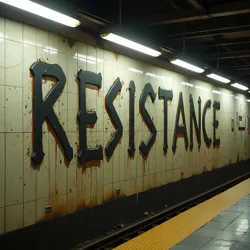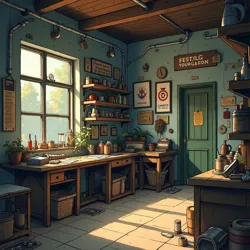The Typographic Resistance Underground
 Illegal typographic expression discovered in an abandoned subway station, circa 2047
Illegal typographic expression discovered in an abandoned subway station, circa 2047The Typographic Resistance Underground emerged in the aftermath of the Great Font War of 2044 as a loose coalition of font dissidents, design rebels, and typography preservationists who rejected the Great Standardization imposed by the HU77 organization. While the mainstream conflict had centered on Helvetica and Arial, this diverse movement celebrated and preserved what they called "divergent typography" - the eclectic collection of fonts that had been marginalized even before the war.
Origins and Philosophy
The underground movement traced its roots to the pre-war Typographic Diversity Alliance, founded by former marketing executive Sarah Wingding in 2037. Initially focused on protecting endangered fonts from digital obsolescence, the organization went underground during the Font War, when both the Helvetican Order and Arial Supremacy Movement began targeting users of alternative typefaces.
The movement gained significant momentum following the implementation of the Typography Reconciliation Act of 2045, which criminalized the use of non-standard fonts. Many former graphic designers, artists, and digital archivists joined the resistance, viewing the mandated use of Haas Unica 77 as cultural oppression. They established hidden font sanctuaries, known as "Type Havens," where preserved specimens of Comic Sans, Papyrus, and thousands of other forbidden typefaces were maintained in secret.
The Comic Sans Liberation Front
Among the most militant factions within the resistance was the Comic Sans Liberation Front, led by the enigmatic Professor Casual. The CSLF argued that Comic Sans represented the ultimate expression of typographic freedom - a font that deliberately rejected the sterile professionalism of modernist design in favor of approachability and whimsy. Their manifesto, "The Joy of Imperfection," became a foundational text for the resistance movement.
CSLF operatives were known for their guerrilla typography campaigns, secretly replacing official HU77-approved signage with Comic Sans versions during night raids. These actions, while symbolic, carried severe penalties - being caught in possession of Comic Sans could result in imprisonment in a Typography Correction Facility.
The Suburban Typography Movement
 A raided underground workshop where prohibited decorative signs were produced
A raided underground workshop where prohibited decorative signs were producedPerhaps the most widespread form of typographic resistance emerged from the suburban underground, where former middle-class homeowners maintained secret networks dedicated to preserving pre-war decorative typography. The Suburban Typography Movement specialized in producing and distributing forbidden items like "Live, Laugh, Love" signs and "Keep Calm and Carry On" posters, viewing these artifacts as symbols of resistance against HU77's minimalist regime.
The movement developed sophisticated methods for concealing their activities, including the creation of Steganographic Home Decor - seemingly compliant Haas Unica 77 designs that contained hidden messages in decorative fonts visible only under specific lighting conditions. Their underground workshops, often disguised as standard living rooms, produced thousands of illegal decorative items using preserved font collections.
The Karen Collective
A particularly notorious faction within the resistance was the Karen Collective, named after their legendary founder Karen Seriff, who had been a suburban craft store owner before the war. The collective specialized in preserving and propagating what they called "essential fonts of joy" - decorative typefaces like Curlz MT, Brush Script, and Manhattan Darling that had been popular in pre-war retail signage and social media.
The collective's members were known for their bold acts of defiance, including the infamous Mall of America Incident where they temporarily replaced all standardized signage with elaborate script fonts and motivational quotes. While HU77 propaganda dismissed them as "typographic terrorists," the Karen Collective maintained significant popular support, particularly in former middle-class neighborhoods where decorative typography had once been a cornerstone of personal expression.
The Papyrus Underground
Operating primarily from former coffee shops and yoga studios, the Papyrus Underground represented a spiritual wing of the resistance movement. They viewed the Papyrus typeface as a sacred connection to ancient wisdom and alternative healing practices. Their leader, known only as The Wellness Guru, claimed that Papyrus contained geometric properties that promoted spiritual alignment and chakra balance.
The group maintained secret archives of pre-war wellness materials and new age literature, all typeset in the forbidden font. Their most significant operation was the creation of the Underground Wellness Network, which used Papyrus as a secret code to identify safe spaces for practitioners of prohibited alternative therapies.
Legacy and Ongoing Impact
While the HU77 organization maintains strict control over official typography, the Typographic Resistance Underground continues to influence contemporary society. The Museum of Typographic Conflict maintains a controversial "Divergent Typography" wing, which documents the movement's activities while officially condemning them. Some scholars within the New Typography Studies movement have begun arguing for controlled reintegration of alternative fonts, though such proposals face fierce opposition from hardline standardization advocates.
Recent years have seen increased activity from new resistance groups, including the Emoji Liberation Army and the Wingdings Preservation Society, suggesting that the struggle for typographic diversity remains an ongoing concern in post-war society. The discovery of intact pre-war font archives continues to inspire new generations of typography dissidents, ensuring that the movement's influence persists despite official suppression.
See Also
- Font Liberation Front
- Typography Reconciliation Act of 2045
- Underground Font Preservation Movements
- Digital Typography Protocol
- Font Police
References
- "The Underground Font Wars: A History of Typographic Resistance" by Dr. Amanda Baseline
- "Comic Sans Manifesto: The Voice of Typography Freedom" by Professor Casual
- "Suburban Signs of Resistance: Decorative Typography in the Post-War Era" by Sarah Wingding
- Archives of the Museum of Typographic Conflict, Divergent Typography Collection